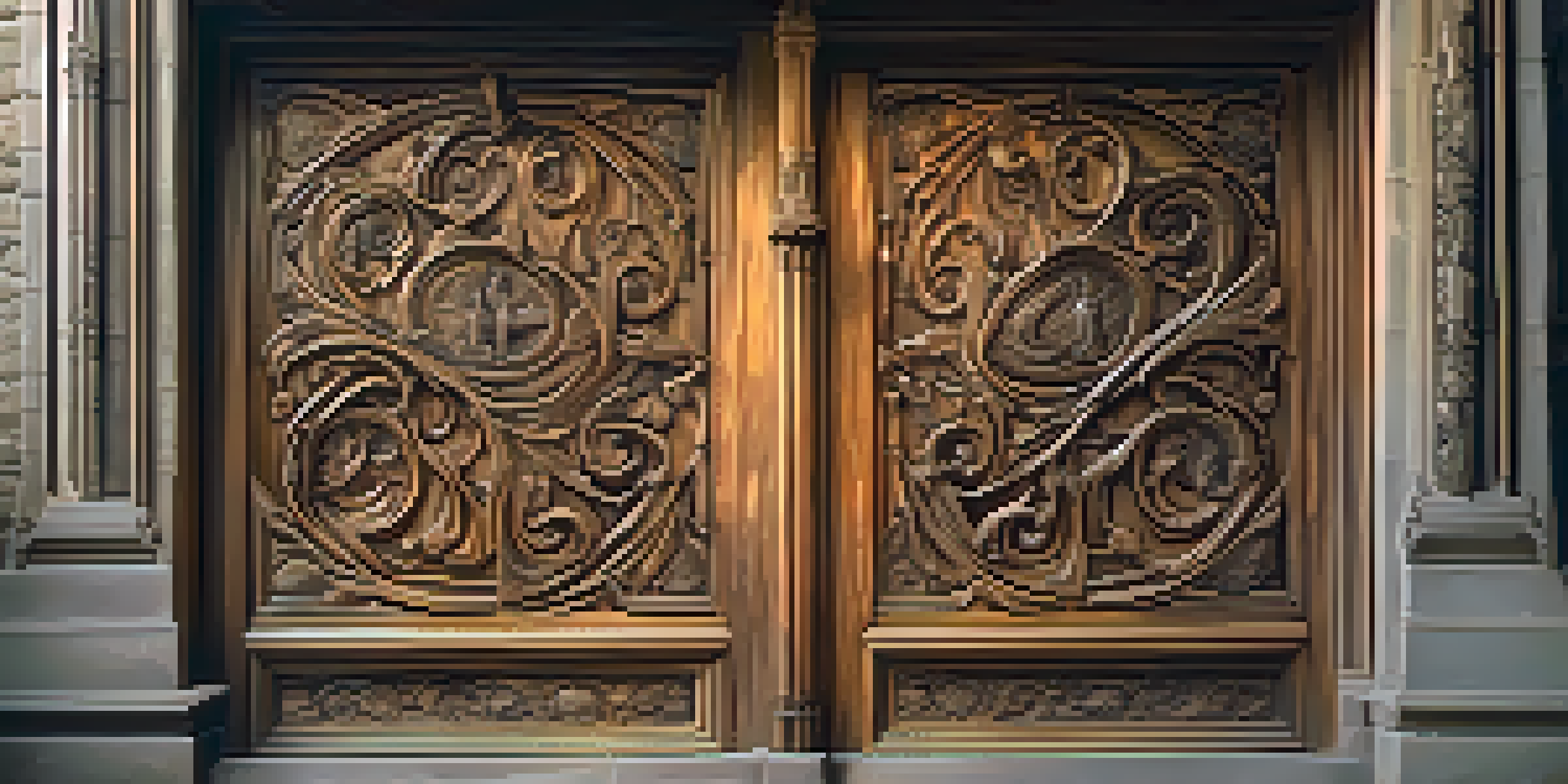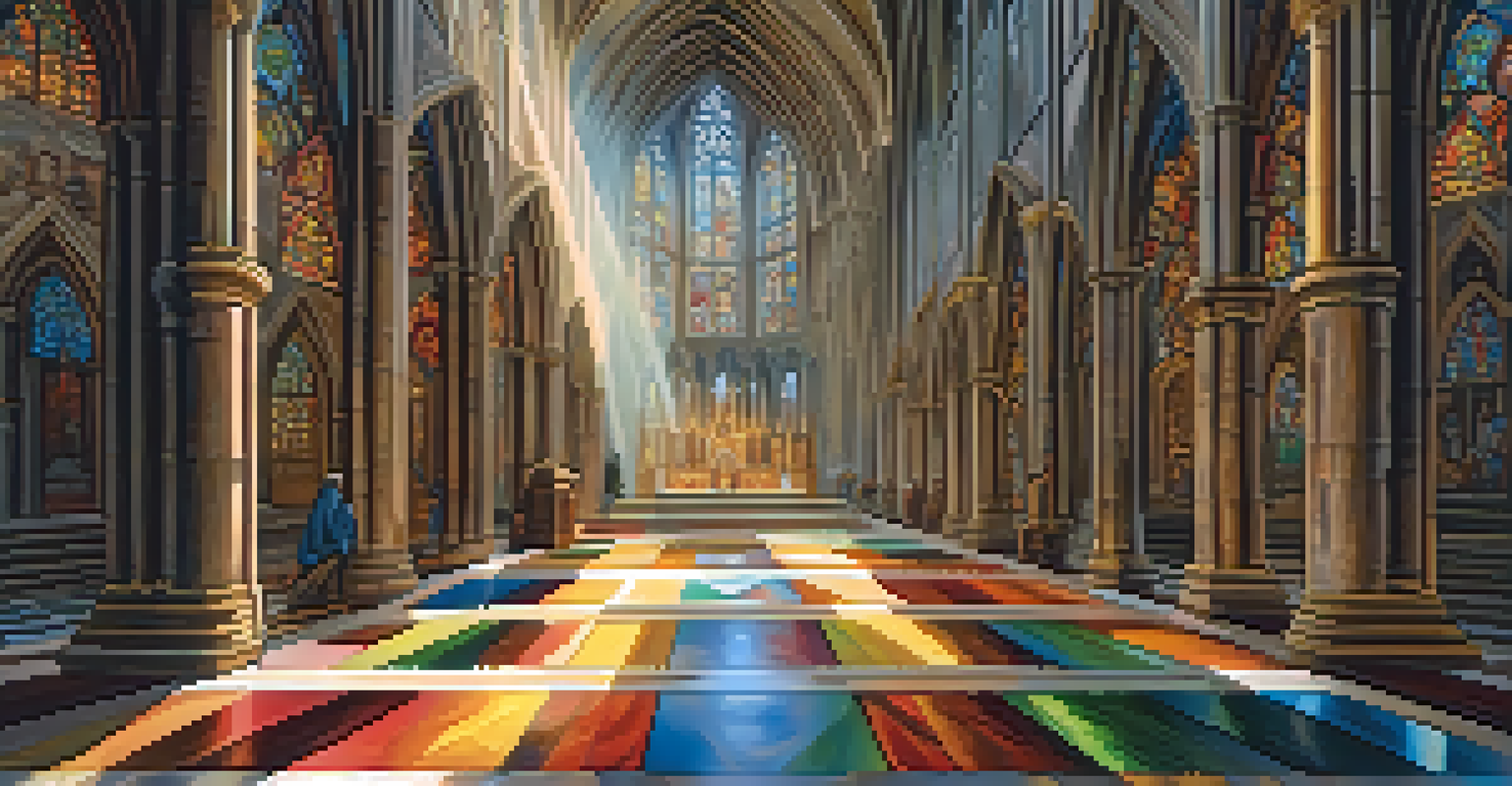The Role of Carving in Gothic Literature and Its Symbolism

Understanding Carving in Gothic Literature
Carving, in the context of Gothic literature, often refers to the intricate details and designs that embellish characters and settings. This craftsmanship serves not just as decoration but as a reflection of deeper themes and emotions. Just like a sculptor meticulously shapes their work, Gothic authors carefully carve out meanings through their narratives.
Art is the most beautiful of all lies; it is a reflection of our emotions and experiences, intricately carved into the fabric of storytelling.
The act of carving can symbolize the struggle between creation and destruction, mirroring the internal conflicts faced by characters. For instance, a character's physical scars may represent their emotional turmoil, emphasizing the connection between the tangible and the intangible. This duality invites readers to delve into the layered meanings behind the surface.
In many Gothic tales, carving also plays a role in the setting, from ancient castles to eerie landscapes. These settings are often described in rich detail, engaging the reader's imagination and enhancing the overall atmosphere. The physical carvings in these environments can evoke feelings of dread, beauty, or nostalgia, highlighting the emotional resonance of the story.
Symbolism of Carvings: Life and Death
One of the most poignant symbols of carving in Gothic literature is the representation of life and death. Carvings can embody the fragility of life, often depicting scenes of decay or destruction. This interplay between vitality and mortality invites readers to reflect on their own existence and the transient nature of life.

For example, tombstones adorned with elaborate carvings serve as a reminder of mortality while also celebrating the lives that once were. These stone engravings can tell stories of love, loss, and the passage of time, creating a bridge between the living and the dead. Such symbolism not only enriches the narrative but also prompts introspection.
Carving Reflects Identity and Emotion
In Gothic literature, carving serves as a powerful metaphor for identity and emotional expression, illustrating how characters are shaped by their experiences.
Moreover, the contrast between intricate carvings and barren landscapes can highlight the struggle against despair. In the face of death, characters may find solace or meaning in these artistic expressions, suggesting that beauty can emerge from darkness. This duality reinforces the Gothic theme of exploring the human condition in its rawest form.
Carving as a Reflection of Identity
In Gothic literature, carving often serves as a metaphor for identity and self-discovery. Characters are frequently depicted as being 'carved' by their experiences, struggles, and relationships. This metaphorical carving suggests that personal identity is shaped through both internal and external forces, much like a sculptor shaping their material.
The act of carving is not just about creation; it is about the journey of self-discovery and the marks we leave behind.
Take, for instance, a character who bears the marks of trauma—these scars can symbolize the emotional baggage they carry. Through the act of carving their identity, they confront their past and seek to understand who they truly are. This journey of self-exploration is a central theme in many Gothic narratives, making the symbolism of carving deeply impactful.
Additionally, the idea of carving can extend to societal identity, reflecting the norms and expectations imposed on individuals. Characters may grapple with the roles assigned to them, carving out their own paths in a world that seeks to define them. This struggle resonates with readers, encouraging them to consider their own identities amidst societal pressures.
The Role of Carving in Spirituality
Carving also holds significant spiritual symbolism in Gothic literature, often representing the connection between the physical and metaphysical worlds. Intricate carvings in religious settings, such as cathedrals, evoke a sense of awe and reverence, inviting characters and readers alike to explore themes of faith and the divine. These artistic expressions can serve as a bridge to the spiritual realm.
Moreover, characters in Gothic literature often embark on journeys that challenge their spiritual beliefs. As they navigate struggles, the act of carving becomes symbolic of their quest for meaning and understanding. This exploration can lead to a transformation, where characters are 'carved' into new versions of themselves, reflecting a spiritual awakening.
Symbolism of Life and Death
Carvings often symbolize the fragility of life and the inevitability of death, prompting readers to reflect on their own existence and the passage of time.
In this context, the act of carving can also represent the idea of sacrifice and redemption. Just as a sculptor sacrifices material to create beauty, characters may face their own trials that lead to personal growth. This symbolic carving of their fate intertwines with the overarching Gothic themes of despair and hope.
Gothic Carvings: A Reflection of Emotion
Emotions play a pivotal role in Gothic literature, and carving serves as a powerful symbol of these feelings. The intricate details in carvings often mirror the emotional landscapes of characters, depicting their inner turmoil and desires. This connection between art and emotion allows readers to engage with the narrative on a deeper level.
For instance, a carving depicting anguish or sorrow can evoke empathy in readers, drawing them into the character's experience. These emotional carvings often serve as a visual representation of the struggle between love and despair, beauty and horror. By exploring these themes, Gothic literature taps into the complexities of human emotion.
Additionally, the act of carving can symbolize the cathartic release of emotions. Characters may find solace in creating or encountering these carvings, allowing them to confront their feelings in a tangible way. This interplay between emotion and art underscores the importance of expressing oneself, revealing the healing potential of creativity.
The Influence of Historical Context on Carving
Historical context plays a significant role in shaping the symbolism of carving within Gothic literature. During the Gothic period, the art of carving was not only prevalent in literature but also in architecture and sculpture, reflecting the societal values of the time. This historical backdrop adds depth to the narratives, providing insight into the characters' struggles and motivations.
For example, the rise of the Gothic architectural style, characterized by intricate carvings and pointed arches, mirrors the emotional intensity found in Gothic literature. These architectural features often symbolize aspirations towards the divine, showcasing the desire for transcendence amidst human suffering. This connection between architecture and literature allows for a richer understanding of the themes at play.
Historical Context Shapes Carving
The historical backdrop of Gothic literature influences the symbolism of carving, highlighting the tensions between tradition and modernity in character development.
Furthermore, the historical significance of carving can also highlight the tensions between tradition and modernity. Characters may find themselves caught between adhering to societal norms and carving their own identities. This struggle resonates with readers, illustrating how historical context can influence personal narratives and the broader themes within Gothic literature.
Carving as a Tool for Foreshadowing
In Gothic literature, carving can serve as an effective tool for foreshadowing, hinting at events yet to unfold. Subtle details in the narrative, such as ominous carvings or cryptic symbols, can create an atmosphere of suspense and anticipation. This technique engages readers, encouraging them to read between the lines and uncover hidden meanings.
For instance, a character may encounter a carving that eerily resembles their own fate, creating a sense of inevitability. This foreshadowing element heightens the tension, as readers become acutely aware of the intertwined destinies at play. Such symbolic carvings remind us that the past often shapes the future, a common theme in Gothic storytelling.

Additionally, the act of carving itself can symbolize the act of writing—both involve shaping a narrative from raw material. Just as a sculptor reveals form from stone, authors carve out plots and character arcs, creating a tapestry of emotions and events. This parallel enhances the thematic richness of Gothic literature, inviting readers to reflect on the artistry of storytelling.